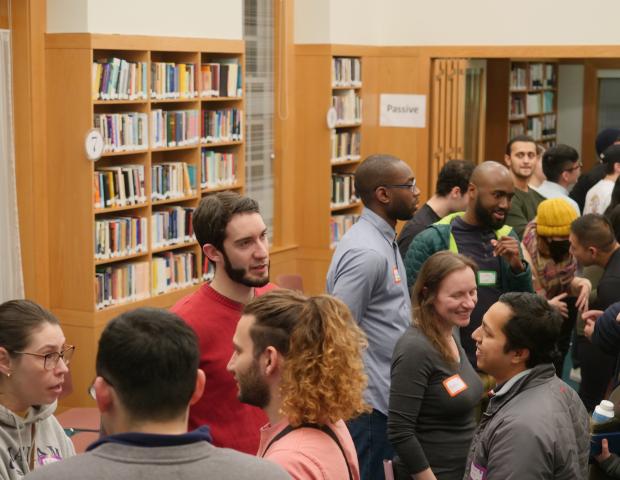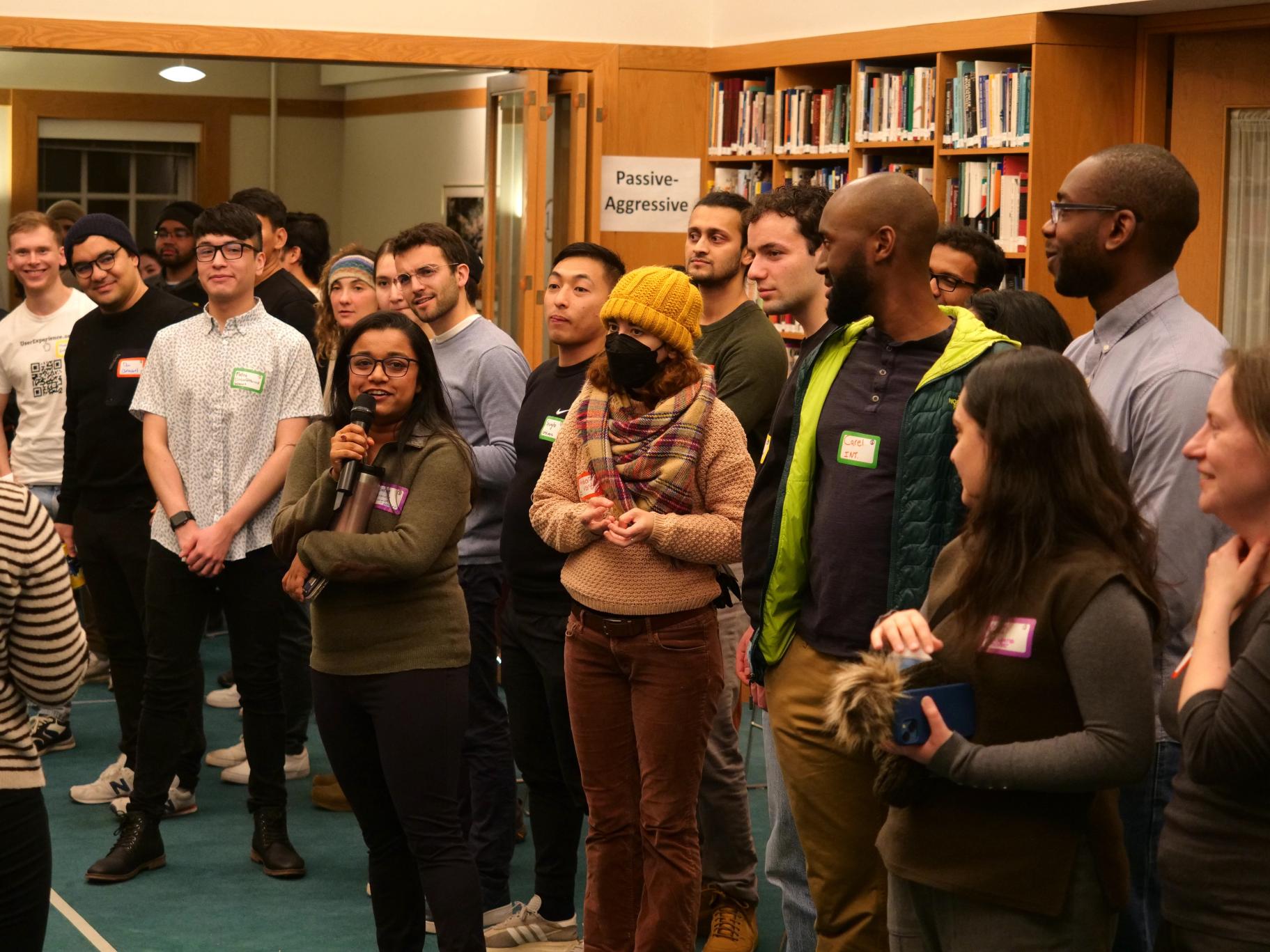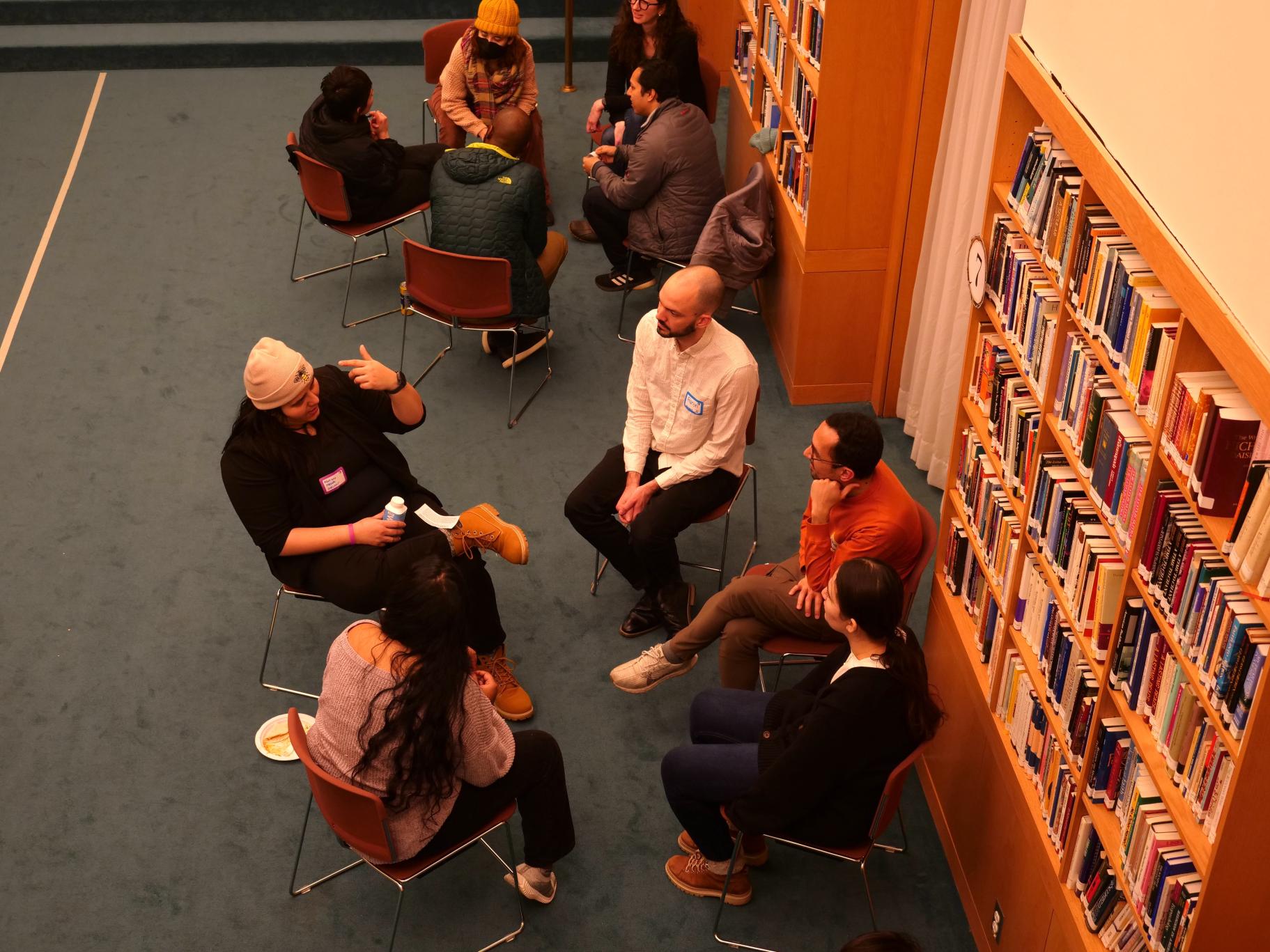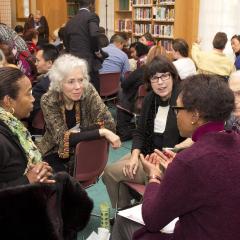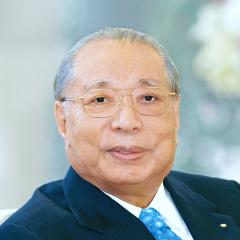Exploring Communication Styles at Dialogue Nights
The first Dialogue Nights of 2025, held on January 31, focused on a key aspect of becoming more effective practitioners of dialogue, namely, understanding one’s communication style. When we know our own tendencies in how we interact verbally with others, we are better able to perceive how we are being received and when and how we might want to adjust our expression to facilitate mutual understanding. The event was intended by nearly 60 Boston-area university students and young professionals, many of whom were first-time attendees.
During her welcoming remarks, the Center’s Preandra Noel said that at each Dialogue Nights “we strive to address themes that speak to what’s top of mind for young people with the hopes that we can create a space for the conversations people want to have, but aren’t having.” As for tonight’s theme, she said that “with everything happening in the world,” the event planning team thought the focus on dialogue and communication would help everyone “remember the power our words have to empower one another and build community.” She added that Center founder Daisaku Ikeda “believed wholeheartedly in dialogue’s potential for peace” and expressed the Center’s wish for everyone to experience that potential over the course of the night.
Before jumping into the evening’s icebreakers, Preandra shared the Center’s four Dialogue Commitments and nine Dialogue Ground Rules, which are informed by the commitments. The former include such principles as “Listen to and learn from each other.” The latter feature guidelines such as “We will give each other the benefit of the doubt and trust that we are all doing the best we can.” The first icebreaker was a round of speed connecting in which participants paired up for a quick dialogue on the topic: What did I learn about myself in 2024 that I didn’t know before? How can I grow from that knowledge? For the next icebreaker, participants were asked to move across a line in accordance with their answers to a series of “This or That” questions. These ranged from offbeat questions like “Would you rather spend a week in the forest or in a real haunted house?” to more serious questions like “Would you rather hear a comforting lie or an uncomfortable truth?” Of this activity, Preandra said, “I hope [it] inspired you to be curious towards the differences that our diversity brings to the spaces that we’re in.”
Proceeding to the main topic of the evening, Preandra introduced a schematic, developed in business settings, that identifies four main communication styles: passive, passive-aggressive, aggressive, and assertive. She then showed a video featuring members of the Ikeda Center Youth Committee (ICYC) commenting on what they perceive to be their own style. Interestingly, the aggressive style was not mentioned by anyone, but the other three all were touched on. Speaking of the passive orientation, one person said that “I’m working on being more assertive, but I struggle to speak up. I don’t like confrontation and it scares me, so I want to have more courage, but yes, [my style is] passive.” Another person put a more positive spin on that orientation, saying that “I don’t want to impose my opinion on somebody else, which is why I will be listening very well, and that’s a quality I’m trying to develop.” Representing the passive-aggressive orientation, one member said, “I tend to hold a lot of things in and not always communicate right away when something’s bothering me or when my feelings are hurt, and then all of that tension starts to build up, build up, build up, build up, and I’m prone to get really upset, burn out, or have resentment towards people.” Another person said they were in the assertive camp, but with qualifications: “I don’t really have fear of sharing my opinion or feelings in groups. With strangers, or with friends or family, I’ll enjoy doing so. But sometimes it also tends to be a little passive aggressive, or every once in a while a little bit aggressive or dominant.” At the same time, they added, “So I’m just trying to continue to practice, um, not always taking up space and holding space for other people.” In other words, “I love just playing with these different communication styles.”
Following the ICYC video, participants paired up to discuss which communication style seems to be “more prominent in your life these days.” Following that 10-minute dialogue, participants then moved into small groups to delve deeper into the topic. For inspiration, Preandra shared a quote from Daisaku Ikeda’s dialogue with Ved Nanda, Our World To Make, that shed light on the deepest reasons for the practice of dialogue.
The objective of dialogue is not to present and push one’s own views but to strive to understand the other party’s perspective and engage in an open, honest dialogue. I would venture to say, at the risk of being misunderstood, that the true value of dialogue lies more in its process than its results. This is because the process of dialogue itself provides an inspiring forum for human beings and civilizations to participate in lively interactions that foster self-restraint and humanitarian competition.
With that and their earlier dialogue in mind, Preandra asked each group to take 25 minutes to explore the question: Reflecting on this quote and your predominant communication style, is there anything you would change about how you communicate with others? Then, for the evening’s next-to-last activity, Preandra invited everyone to reflect in writing for five minutes on the topic of “a conversation that you are avoiding to have and how, if you were to engage in it, you would like that conversation to pan out.” This could be with family or friends, she said, and could address questions such as: What could make this difficult conversation easier to engage in? What would you like to come out of a courageous conversation with them?
The evening concluded with an “open mic” session in which participants could share thoughts and insights that occurred to them as they engaged in the various activities. Commenting on the value of this practice, Preandra said that she “once read that an open mic is the living embodiment of intersectionality.” This is because, “in a world where it is easy to be silenced or be a silent majority, the mic empowers one to courageously use their voice to share and once someone shares, that moment becomes a point of exposure to our interconnections.” Here are some highlights from participants’ open mic observations.
- I think that one of the good takeaways from today would be that every time you’re sort of experiencing something new, or when you’re trying something new out, to just give it a little time. And, you know, eventually it will become a lot easier.
- I want to encourage people to sit down by themselves in a room. With a closed door, and have a dialogue with whatever you think is out there. Whether it’s the ether, or the universe, or God, or whatever. Just sit down for a couple of minutes and say what’s on your mind. I think you’ll be pleasantly surprised with what happens.
- I’m not sure if these labels that we have for communication styles are … super-accurate or super-nonjudgmental. [For example,] I usually think of passive as more subtle and assertive as more obtuse. And I think that there’s a time and place for both, and that people are generally multiple types of communicators [depending on] circumstances.
- I just moved here two days ago and I have to say that this is nice place to happen to come across. I woke up this morning not knowing what I was gonna do, and then my buddy was like, Hey, let’s go here. And we didn’t know what to expect and this is just a really nice and welcoming place. So I just want to say thanks for creating this safe space.
